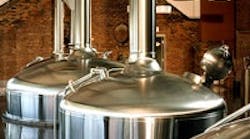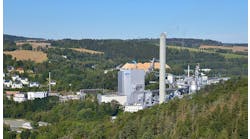By Walt Boyes, Editor-in-Chief
Pepsi Bottling Group (PBG) is a global enterprise, and no matter where it sites bottling facilities, it wants to produce as close to the same product as it does anywhere else. International growth accounts for about 72 percent of Pepsi's growth (based on 2008 numbers), so the company believes that it is critical for PBG to develop manufacturing operations that are repeatable from country to country and continent to continent. PBG calls this the Optimized Packaging Plant.
In 2005, Pepsi began construction of a new bottling facility in South Moscow, Russia. Pepsi's challenge was to produce soft drinks quickly enough to meet the demands of the growing Russian market. In 1974, Pepsi made its commercial debut in the Soviet Union. For history buffs, that was 15 years after Nikita Krushchev took a sip of Pepsi during his visit to the United States. But by 2005 Russian GDP was growing at approximately 7 percent and disposable income rising 26 percent per year. By 2005, the demand for Pepsi products was booming.
Pepsi began its South Moscow facility as a greenfield plant that would be state-of-the- art, and would begin producing Lipton teas in June of 2009. Pepsi needed to automate processes that ranged from discrete packaging systems to batch and continuous tea brewing processes, and a variety of hybrid processes in between. It was Pepsi's stated intention to build a showpiece plant from the ground up.
The designers started from first principles. Siemens was chosen as the automation supplier. "We started by asking Siemens to look at the way we do business and tell us what an optimized plant looks like," said Rajendra Gursahaney, Senior Engineering Director International at Pepsi Bottling Group. Siemens reviewed several existing Pepsi plants in different countries and returned with formal recommendations.
"We asked Siemens to recommend hardware, network architecture and an overall package of equivalent components," Gursahaney said, "with equal or better functionality at an equal or better price." PBG's goal was to standardize the equipment and ensure complete interoperability between components, based on the OMAC (Organization for Machine Automation and Control) standards.
Siemens recommended an approach that both it and PBG called the Optimized Packaging Plant concept, or OPP. Over the next three years, PBG and Siemens worked together to crystallize their thinking about the OPP. In June 2009, the OPP became a reality as the South Moscow Pepsi Bottling Group plant began shipping hot filled Lipton Tea.
Pepsi realized the power of standardizing the information going into every data block. In order for the data block to serve as a buffer between the machine and the network, it must have the correct information. PBG required all vendors to standardize what goes into each data block in every controller, seamlessly collecting real-time information and then aggregating it over the network.
This interoperability and seamless communications also give the South Moscow plant a high degree of visualization. This is the number one differentiator between it and the North Moscow plant, built earlier. At any given moment, the plant manager can view each line of his operations of a computer screen with red, yellow and green colors indicating status. Touch controls on the graphical user interface (GUI) allow him to zoom in on a red line, for example, to determine the cause of a malfunction, even down to the level of an individual valve on a filling machine.
"The high degree of visualization really puts all of the information you need at any given moment at your disposal," Gursahaney said.
The impact of the OPP blueprint can be felt throughout the South Moscow plant. There were immediate improvements in training, diagnostics, maintenance and, ultimately, productivity when measured against the North Moscow facility. "The OPP improves our operations across the board," Gursahaney said, "because, simply put, the information is much better."
By standardizing on equipment used by all suppliers, PBG's operators spend far less time in training. "Training hours can be reduced," Gursahaney said, "because you are training operators on one PLC, not sixteen." In addition, he noted, working repeatedly on one type of equipment gives operators the opportunity to deepen their knowledge and increase their contribution to overall operations.
The improved level of self-diagnostics that PBG demanded provided instantaneous troubleshooting of problems as soon as the alarm occurred, staving off potential entire line shutdowns. Significant improvements in maintenance also are becoming possible because the operators and plant managers can track and archive information about downtime in a single database. For example, if one filler is down an average of twenty percent of the time, maintenance supervisors can look at the data and find out that the actual culprit was as simple as one jam on a transfer star or a malfunction of a single valve.
"We measure uptime through efficiency," Gursahaney said. "While it is a little too early to tell since we just started operations in June of 2009, I would expect the efficiency of the South Moscow plant to overtake the North Moscow plant by four to five percentage points very soon."
As with like most consumer-facing companies, sustainability is on Pepsi's front burner. PBG has Siemens already working to monitor and reduce energy consumption on large drives, as well as other ways to reduce Pepsi's carbon footprint. Increasingly, PBG customers want their soft drinks to be produced with as little impact on the environment as possible. Pepsi Bottling Group aims to deliver.




